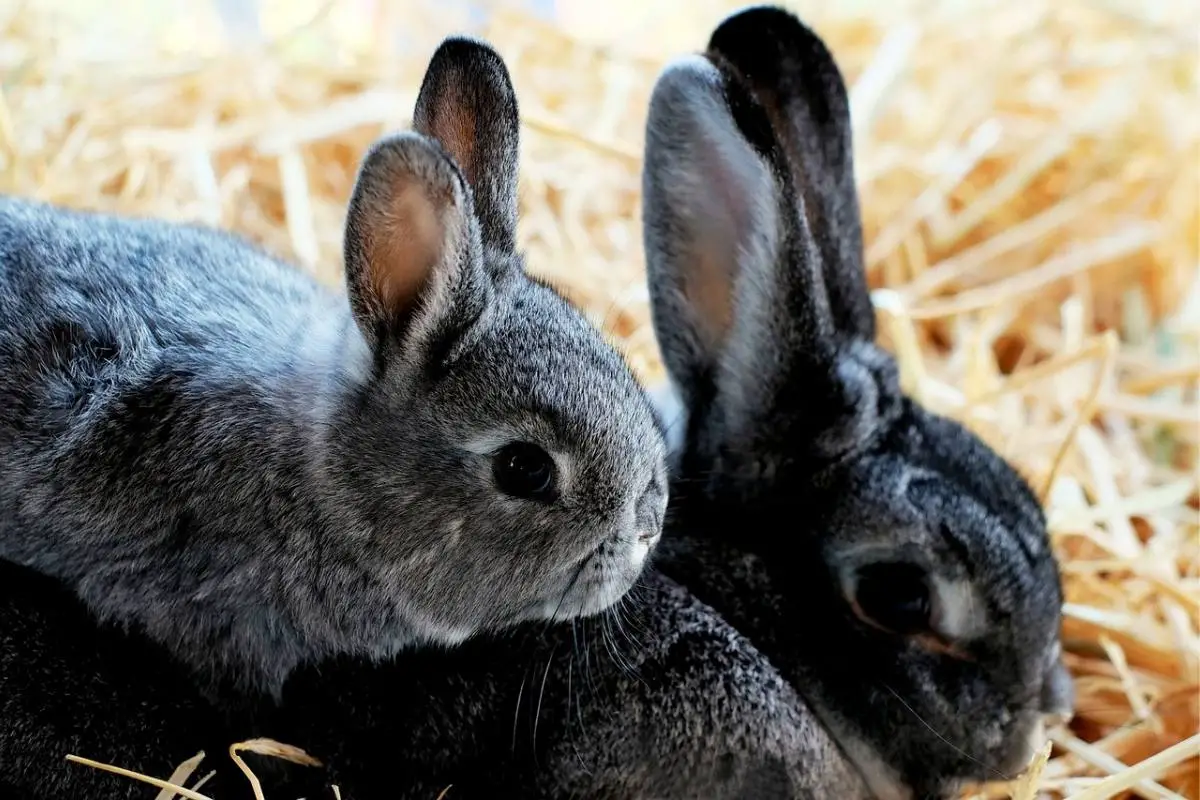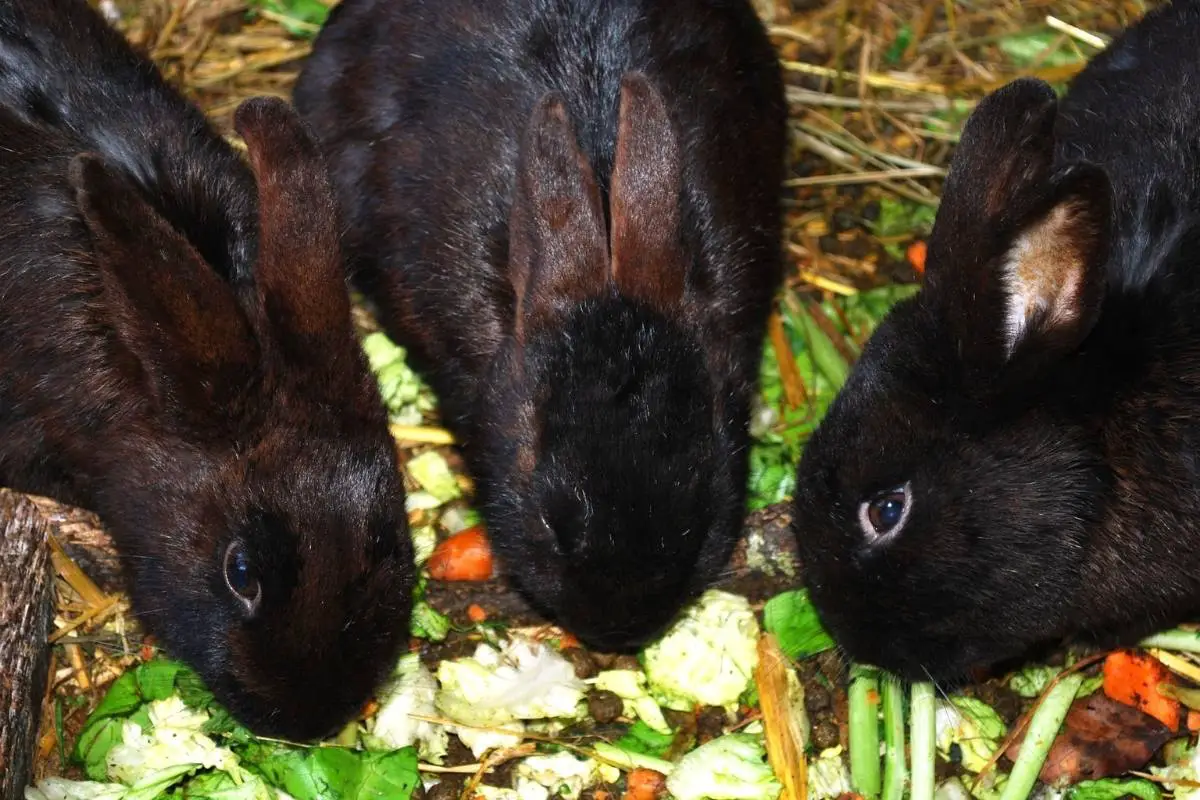Having rabbits in your home is a wonderful, albeit somewhat demanding, experience. Some aspects of bunny ownership pose different challenges than the ones presented by cats or dogs, such as how to feed multiple rabbits under one roof. There are quite a few things to consider, but luckily there are an equal amount of ways to ensure everyone gets their fair share at dinnertime.
So, can rabbits share a food bowl? Depending on the circumstances, absolutely; domestic rabbits can and often do share food bowls.
This article will examine the ideal scenario in which domestic rabbits could share a food bowl as well as some circumstances to consider when deciding whether to have your bunnies dine together. We will discuss bonded pairs, size, age, and eating habits, as well as rabbit hierarchy and other behaviors.
Rabbit Bonds and Social Nature

Rabbits in the wild are highly social animals. They typically live within large family groups called warrens and depend heavily on one another for support of all kinds, from physical needs like grooming to emotional support such as when a bonded rabbit loses its mate.
Because rabbits have not been domesticated for long when compared to other animals such as cats or dogs, these instincts are still quite strong in our cotton-tailed companions at home.
Most people who share their homes with rabbits keep them in pairs or groups for this reason. Keeping a single rabbit is not unheard of and likely will not be detrimental to your rabbit provided you are giving them ample attention and stimulation, but it is not usually the norm.
If you obtained your pets as a bonded pair, chances are they already share almost everything, food bowls included. If you had a single rabbit and are now bringing another into your home, you likely will have to go through what could be a lengthy process called bonding.
This is in the best interest of both your bunnies and your sanity, and although it takes a great deal of patience it will be worth it to have happy, healthy buns. There are plenty of resources available to help you through the process of bonding, but it is always a great idea to start with local rescues or your rabbits’ veterinarian to figure out where to begin.
Once you have a bonded pair or several bonded pairs of rabbits, sharing food bowls should not pose any problems. If your bunnies are familiar and comfortable with one another and accept the hierarchy in your “home warren,” sharing food bowls, water bowls/bottles, and hay likely is the most efficient way for you to feed them.
Further, they probably would prefer it that way anyway. Sharing these things within their common space usually promotes deeper bonding in a pair.
You may notice if you give two bowls at dinner time or if you have two separate hay racks that your rabbits will spend time at each one regardless of what rack or bowl was meant for whom, so having them share is usually best for everyone.
If you do decide to have your bunnies share a bowl, it is a good idea to keep an eye on each rabbit and their respective size and eating habits, as many rabbits have different nutritional needs.
Size, Age, and Habits

When determining whether to have your furry friends share a bowl at mealtimes, considering their bond is just the start. You should also account for your pet’s sizes, ages, and eating habits.
Further, it is important to understand the needs of your specific breeds, their activity levels, and even phases of life such as molting, when a rabbit sheds its coat (around two to three times a year). Maintaining the correct diet for each rabbit is important to their health and welfare, and like any animal, every rabbit has different needs.
For example, baby and young rabbits need higher protein content in their diet, as do pregnant and nursing mother rabbits. Additionally, breeds with longer hair such as lionheads or angoras need higher protein and more dry food to help them maintain their coat.
Small rabbits like dwarf and pygmy breeds tend to burn energy faster than larger breeds like checkered or Flemish giants, meaning they are more active, even at rest, and may need more food per pound, although they are tiny in comparison.
Conversely, rabbits who are newly spayed or neutered, rabbits who are overweight, and/or rabbits who are generally less active typically have fewer nutritional requirements than those previously discussed.
Further still, some differences could simply boil down to a rabbit’s personality. Some rabbits enjoy nibbling and taking their time during meals while others are compelled to scarf their meals down quickly so they can get back to play time.
The characteristics listed above are not all-inclusive, but they are a good start to understanding the differences in nutritional needs between your rabbits. Note these differences once you introduce a shared food bowl and observe their behaviors to make sure one rabbit is not taking the lion’s share of food.
This may happen sometimes if one rabbit is substantially larger or more active than the other and could result in the need to separate at mealtimes to ensure everyone is getting what they need.
If you have determined your rabbits have approximately the same nutritional needs but have noticed that one still eats first or more than the other, it could be related to hierarchical or dominance behavior.
Hierarchical and Dominance Behavior

In addition to being social creatures, rabbits are also hierarchical. This means that in the wild, rabbit warrens typically consist of a dominant mating pair with multiple subordinate pairs or family groups beneath them.
This hierarchy is vital to the survival of the warren as the dominant pairs are usually the strongest, fastest, and most prolific breeders. Additionally, the hierarchy ensures peace is (mostly) kept within a warren and ensures its safety against predators.
Like many other instincts our furry friends retained during the domestication process, hierarchical and dominance behaviors are still very much a part of the pet rabbit’s life. If your household is a multi-rabbit one, you may have already noticed one or two of your rabbits attempting to establish dominance, perhaps through some of the following behaviors:
- Mounting (both male and female)
- Chasing or circling
- Nipping or biting
- Barbering (aggressive grooming sometimes resulting in pain or injury)
- Hoarding
These are just a few behaviors used to show dominance, but if your pets are displaying any of these signals make sure to keep an eye out during mealtimes. Often, the dominant rabbit gets “first dibs” of available food and could take advantage of that, resulting in the subordinate rabbit or rabbits not meeting their nutritional needs.
If this were the case, mealtime separation likely is the best solution. However, if all rabbits in your “home warren” are comfortable with their hierarchy’s status quo, they might be perfectly content to wait their turn. Therefore, knowing each of your rabbits’ individual needs and behaviors is especially important when having them share a food bowl.
If your rabbits have similar nutritional requirements and do not seem to have any dominance-related issues, but you are still experiencing some mealtime foibles after introducing the shared bowl, territorial instincts may be causing some tension.
Territorial Behavior
Having read this far, you may be wondering to yourself what else could possibly be going on in your rabbit’s fuzzy little head. Rabbits are quite complex, so on top of being social creatures and beyond their dominant and hierarchical needs, they are also highly territorial animals.
Rabbits seriously value their own spaces and go to great lengths, both in the wild and in our homes, to make sure everyone around knows what space belongs to them. Rabbits mark in multiple ways including “chinning,” (rubbing their face and chin on things), scattering droppings, and in the case of intact males, spraying.
If you have introduced a shared food bowl and one or more of your rabbits will not eat from it, it could be that one of your other furry friends has marked the bowl itself or the area in which you placed it as theirs.
If this is the case, your other pals likely will not use that bowl or area out of respect for the other rabbit’s space. Launder any blankets or towels and wipe down hard surfaces in the shared area, including the bowl, with white vinegar to neutralize the scent and try again. If territoriality remains an issue, you may simply need to keep them separated at mealtimes.
Conclusion
If you have happy, bonded rabbits who are comfortable with each other and within their environment, having them share a food bowl is not only acceptable, it is beneficial to both the rabbits and to you. It is efficient for you and strengthens the bond between your bunnies.
If you are introducing a shared food bowl to a newly bonded pair or pairs, make sure to familiarize yourself with each rabbit’s nutritional requirements to ensure everyone is getting what they need.
Further, observe your bunny’s behaviors to make sure that dominance or territorial signals are not causing any tension during mealtimes that could be preventing your friends from getting their share.
If you have covered all your bases and your bunnies are happy, sharing a food bowl, and even water bowls and hay racks, is a perfectly good way to provide for your furry friends.

